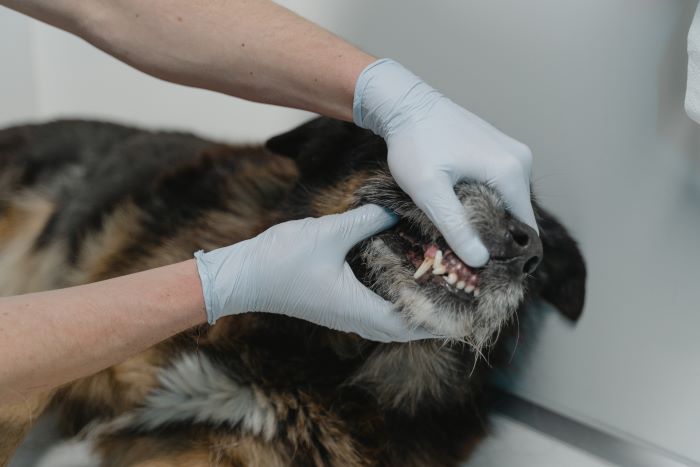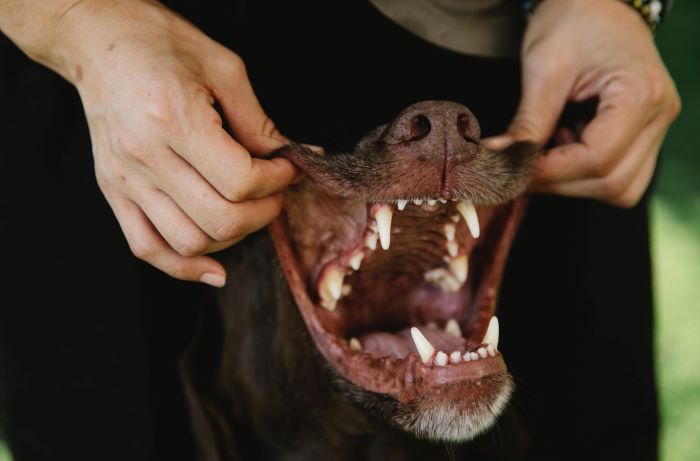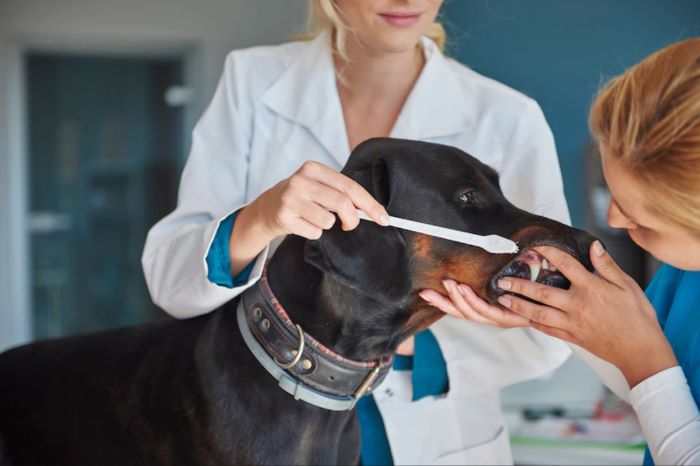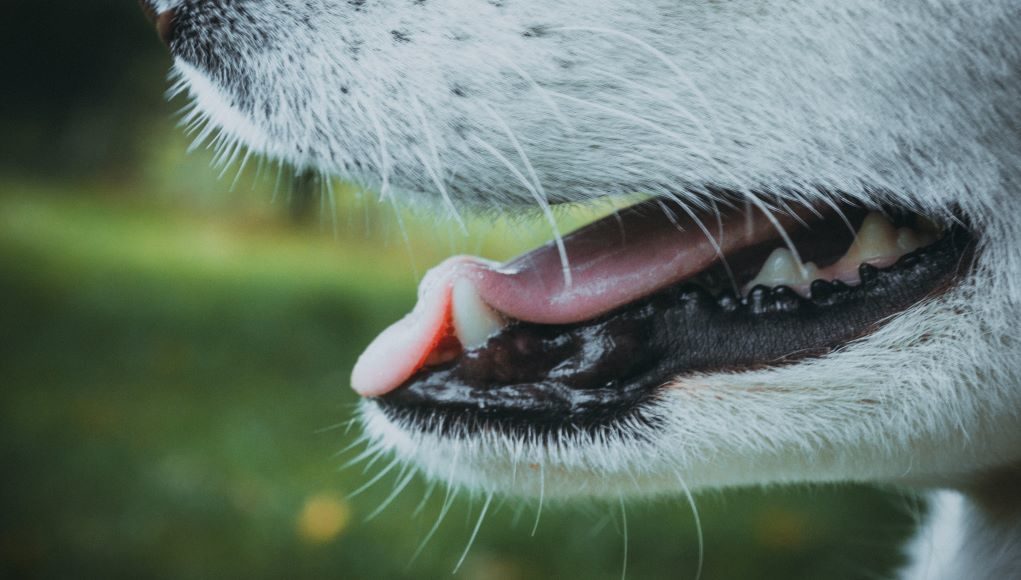Table of Contents
- What are Dog Gum Problems to Look Out
- What Color Should Your Dog’s Gums Be?
- Breeds Affected the Most by Gum Problems
- Causes of Gum Problems in Dogs
- Symptoms of Gum Problems in Dogs
- How Are Gum Problems Diagnosed?
- Treatment for Gum Problems in Dogs
- Can Gum Problems Lead to Any Complications?
- How to Prevent Gum Problems in Dogs
- Dog Gum Problems: Summary
Did you know that according to research, 77 percent of dogs seen at the Banfield Pet Hospital USA in 2019 were suffering from dental disease?
Whether you’re a dog owner or an animal enthusiast, learning about this paw-some creature’s physical health is essential.
Statistics indicate that poor oral hygiene is at an all-time high among pets.
To ensure the optimum health of your adorable and strong dogs, we have compiled all the information on dog gum problems.
Common conditions, at-risk breeds, diagnosis, treatment, and prevention, we will cover it all! So, without further ado, let’s get started!
What are Dog Gum Problems to Look Out
Dog owners often complain about their pet’s bad breath.
Although a slight odor is typical for dogs, stinky exhalation may indicate an underlying health concern.
Gum problems mostly affect dogs over three years old. Despite their high prevalence, gum problems are severely underdiagnosed and often go untreated.
The most common gum-related problem in dogs is periodontal disease. It is an infectious disease and causes inflammation of the gums.
If left untreated, it can eventually contaminate the bones and supporting tissues. This will lead to the teeth becoming loose and falling off.
This is a gradual process. But you must understand the severity of the problem your pet is facing.
Here are the general gum-related problems among dogs listed by least to most serious:
Plaque
This is the daily accumulation of bacteria in your dog’s mouth.
It is worth mentioning that plaque is easily removed through regular brushing.
Tartar
if plaque is not removed, it eventually hardens into a substance known as tartar.
Gingivitis
When tartar starts to spread, it digs into the gum tissue, causing redness and inflammation.
Periodontitis
the plaque bacteria produce toxic substances that stimulate the dog’s immune system.
By the time the white blood cells destroy the bacterial invaders, a lot of damage has already been caused to the surrounding gums and tissue.
Tooth root abscess
The bacteria start digging deeper into the roots of the teeth, destroying their connection to the jaw.
This cuts off blood circulation, triggering the immune system to send white blood cells to address the situation.
But the infected tissue may already be dead by this point. Surgical intervention becomes necessary under these conditions.
Loss of teeth
if the tissue and gums become too weak, the teeth may become loose and fall out.
If the infected tooth is causing pain, the vet may also decide to remove it.

What Color Should Your Dog’s Gums Be?
Monitoring the color of your dog’s gums can be a great way to examine their health at home.
Always be vigilant of any changes, as this will assist you in determining if they have any gum problems.
Three factors indicate good oral health, including:
1. The Color of Your Dog’s Gums
The color of your pet’s gums should range from salmon pink to light pink. Anything other than this may indicate an underlying medical condition.
Different dog breeds have different colored gums from the very start. Think about your pet’s gums in the past and take pictures to track any changes.
Here is what the color of your dog’s gums reveals about their health:
● Blue or Purple Gums
These can occur due to insufficient oxygen in your dog’s blood.
Termed “cyanosis”, it can result from pneumonia, congestive heart failure, and other respiratory conditions.
These are all quite serious, and we recommend taking your dog to the vet immediately.
● White or Light Pink Gums
This can be caused by a lack of blood or hemoglobin in your pet’s body.
Since the body has insufficient blood to circulate, the normal shade of pink fades, and the gums become pale.
There may be two reasons for this: anemia or acute blood loss.
Anemia is caused by insufficient production of red blood cells, and blood loss can be caused by cancer, stomach ulcers, or an injury.
You must contact your local vet immediately and schedule a checkup.
● Bright Red Gums
The greatest contributing factor to bright red gums in dogs is overheating.
As a dog’s temperature rises, blood transfers to the gums to help cool off excess heat.
This leads to the dog panting heavily to reduce its core temperature. Bright red gums can also be a sign of inflammation.
● Yellow gums
These result from liver problems, most probably jaundice.
You may notice a yellow discoloration on your dog’s eyes, skin, and gums.
This will be more visible on dogs with lighter fur and gums than those with darker ones.
2. How Their Gums Feel When Touched
Your dog’s gums should feel moist, slippery, and smooth when you run your fingers over them.
They should not be dry or sticky. Anything other than this could be concerning.
3. Refill time
When you press your index fingers on your dog’s gums, they will change color for a second. For example, they may turn a pale pink or white color.
The rule here is this: if they are healthy, the color will change back to normal in a few seconds after you lift your finger.
Anything other than this should be observed and relayed to the vet.
The time it takes to return to the original color is known as “refill time”. This is very helpful when making a diagnosis.

Breeds Affected the Most by Gum Problems
Research suggests that breeds of smaller sizes are much more likely to develop gum problems. These include:
- Toy Poodles
- King Charles Spaniel
- Cavalier King Charles Spaniel
- Greyhounds
- Dachshund
- Yorkie
- Bulldog
The same research also showed a positive correlation between the severity of the disease and age.
In other words, as dogs grow older, the likelihood of developing serious gum problems increases.
Causes of Gum Problems in Dogs
Most major gum-related problems in dogs are due to the accumulation of bacteria in your pet’s mouth.
When not cleaned, the combination of minerals and salvia cause them to harden.
This relatively stronger layer of bacteria is known as tartar.
The cause here is easily identifiable: the accumulation of bacteria, which can be easily removed by regularly brushing your beloved doggo’s teeth.
If you have a good oral hygiene schedule, it is important to remember that other factors may also be at play. These include:
- Poor nutrition
- Poor grooming habits
- The alignment of teeth (This varies, depending on the breed)
- Unclean toys

Symptoms of Gum Problems in Dogs
Any potential gum problems may be difficult to detect in your doggo during the initial stages.
This is because gum problems are subtle and not easily identifiable until the disease progresses.
Many things can indicate gum problems in dogs. These include:
- Your dog's gums may bleed or become inflamed, especially while brushing or chewing food and dog toys. That is an early sign of gum disease.
- The teeth may become brown or yellow. Although multiple factors can cause this, the accumulation of tartar along the gum line is the most likely culprit.
- Your dog may exhibit bad breath, also known as halitosis. This is due to the buildup of bacteria feeding on leftover food particles in the mouth.
- Your dog may only use one side of the mouth while chewing. This is because using the infected area can be painful.
- Your dog’s chew toys may have traces of blood on them. You may also observe your dog’s saliva becoming bloody or ‘ropey’.
- Signs of unusual irritability and aggression. This is the physical pain manifesting through behavior.
- There may be an observable loss in appetite.
- You may observe a fall in your dog’s overall weight. This is because of the reduced appetite and the weakness caused by the infection.
- Your dog may start losing teeth. That is usually the sign of late-stage periodontal disease.
- They may flinch when you try to lift their lips to examine their teeth.
- They may stop playing with their favorite chew toys due to toothache.
It is also worth mentioning that your pet may start self-isolating to deal with the pain.
Pets can become socially withdrawn to protect themselves from potential predators.
It is best to get your dog examined and diagnosed by a professional. Your vet will prescribe suitable treatment and medication.
You may be wondering, “What can I expect when I walk into my local vet clinic?”. Well, worry not!
We will be discussing the relevant course of action in the next section. Read on to find out.
How Are Gum Problems Diagnosed?
Dental problems are easily diagnosable during your dog’s regular checkups.
If the vet sees a problem, they may do a complete dental examination.
This includes a visual checkup and imaging techniques like x-rays if required.
Treatment for Gum Problems in Dogs
Treatment for gum problems in dogs can vary depending on the severity of the condition. There are three main courses of action:
Deep dental cleaning and fluoride application
This is for when there isn't much plaque buildup.
Scaling or scraping
This is used when there is a moderate build-up of tartar. This may be followed by teeth polishing.
This reduces the chances of food sticking to the teeth in the future. (Note: local anesthesia will be used during this procedure).
Extraction
This is only done when the buildup has caused too much damage to the teeth, tissues, and gums.
After thoroughly examining your beloved pet, your vet will provide the most suitable option.
Antibiotics are often used to fight off infections as well. We urge you not to worry though. Your pet will be healthy and thriving soon enough.
Can Gum Problems Lead to Any Complications?
If left untreated, gum problems can lead to further complications. These include:
- Heart disease
- Vision problems
- Jaw fracture
- Oral cancer
We recommend following up on your pet’s routine checkups. An early diagnosis will help your dog recover at a much faster pace.

How to Prevent Gum Problems in Dogs
“Prevention is better than cure”. We have all heard that at some point in our lives.
But how do we apply that to our pets? Here are a few tips to ensure optimum oral health:
- Brush your dog’s teeth daily. That will help minimize the accumulation of plaque and bacteria in the mouth.
- Check for bad breath, redness, and inflammation every week. Make it a habit to do this at the same time every week to ensure that you never forget.
- You can also ask your vet to recommend a diet based on the age and breed of your pet.
- Carry out a thorough physical checkup every few months. If you have a small breed, you must get a checkup monthly.
Remember: An early diagnosis will lead to early treatment. The early stages of gum problems are reversible.
If you are looking for home remedies for gum problems, you can take guidance from this great YouTube video:
Dog Gum Problems: Summary
While gum-related problems may seem scary, they are preventable and treatable if diagnosed on time.
With regular brushing and checkups, your doggo will stay healthy and active.
If you suspect an underlying health condition, it is better to get a professional opinion.
Your vet will prescribe the most suitable course of action, depending on the severity of the condition.
Dogs need us as much as we need them! Always ensure a balanced diet for your pet and make sure they get plenty of exercise.
Always do regular brushing of teeth and dental check-ups to make sure their gums are in tip-top shape! That way, you might just avoid some of the dog gum problems on this list!













